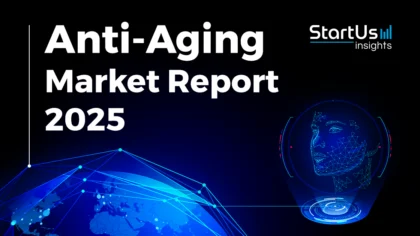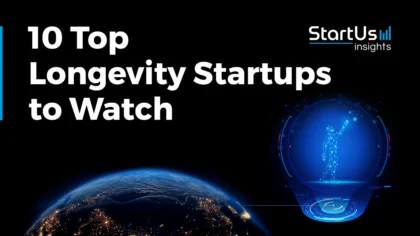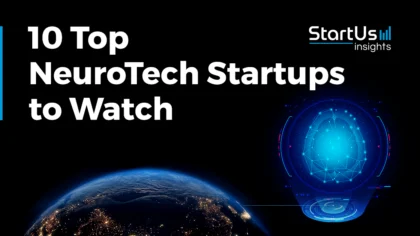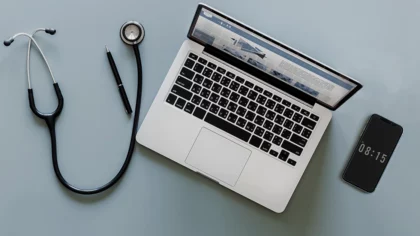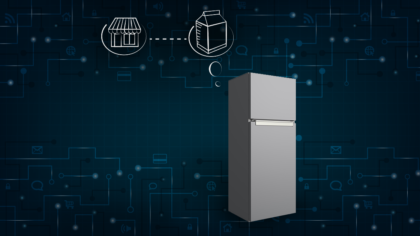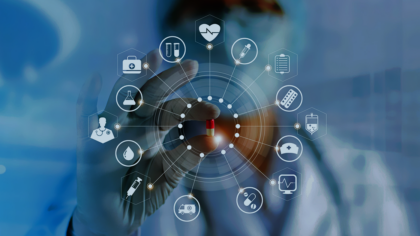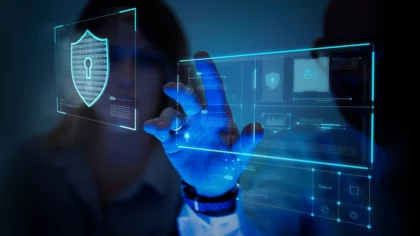Accelerate Productivity in 2025
Reignite Growth Despite the Global Slowdown
Advanced monitoring and data-driven solutions are reshaping patient care in the healthcare sector through the Internet of Things (IoT).
According to Polaris Market Research, IoT in healthcare is anticipated to grow from USD 148.7 billion in 2024 to USD 556.71 billion by 2032, exhibiting 17.9%.
The rising awareness has underscored the potential of IoT in the healthcare industry where it improves the management of chronic diseases and the operations of hospitals.
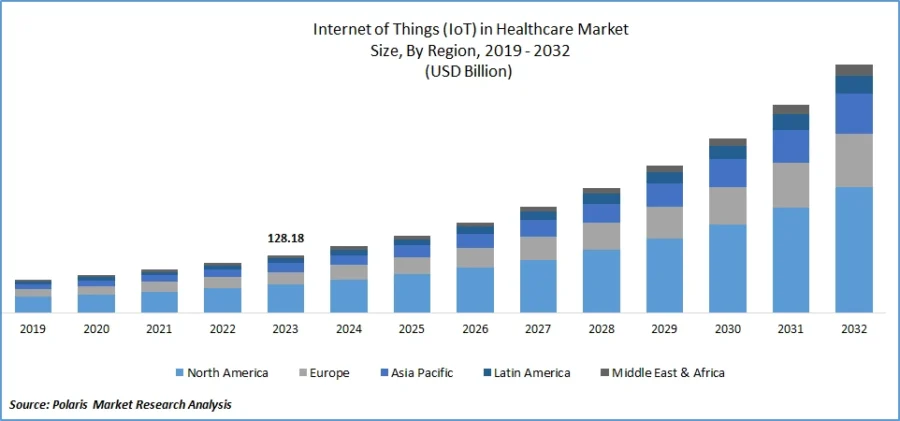
Source: Polaris Market Research
For example, PatchRx creates intelligent pill-bottle caps to facilitate medication adherence, while Wellysis provides wearable ECG patches that continuously monitor cardiac activity. These technologies not only improve diagnostic accuracy but also optimize the delivery of care.
This article reveals the most recent IoT applications that are driving healthcare innovations, including real-time monitoring and asset tracking, thereby improving patient care and overall well-being.
Why should you read this report?
- Gain in-depth insights into the top 8+ use cases of IoT in Healthcare
- Meet 8+ innovative startups advancing these applications

What is the future of IoT in healthcare?
The future of IoT in the healthcare industry points towards advanced integration of IoT applications in healthcare to enable real-time monitoring, predictive analytics, and AI-based diagnostics.
For instance, devices like wearables track chronic conditions, while smart hospitals leverage IoT to improve operational efficiency through automated asset tracking and predictive maintenance.

Source: Polaris Market Research
In the future, we will witness IoT’s role to extend in telemedicine where it will leverage 5G for faster data transfer. This will lead to more precise remote healthcare and greater patient engagement.
What are the benefits of IoT in Healthcare?
The benefits of IoT in the healthcare sector include real-time data collection through IoT-enabled devices, improving patient care by offering timely interventions, and better chronic disease management. IoT applications such as smart medication dispensers and connected devices in healthcare systems improve medication adherence and reduce hospital visits.
IoT is utilized in the predictive maintenance of medical equipment that optimizes hospital operations by preventing equipment failure. This technology ultimately streamlines processes, improves patient outcomes, and enhances overall efficiency in healthcare delivery.
Key Takeaways
- Remote Patient Monitoring
- Use Cases:
- Chronic Disease Management
- Wearable ECG Monitors
- Sleep Apnea Monitoring
- Startup to Watch: Wellysis
- Use Cases:
- Smart Medication Dispensers
- Use Cases:
- Smart Pill Bottles
- Connected Inhalers
- Automated Pain Medication Dispensers
- Startup to Watch: PatchRx
- Use Cases:
- Telemedicine and Virtual Care
- Use Cases:
- Connected Diagnostic Tools
- Symptom Tracking
- Tele-Surgeries
- Startup to Watch: Fifth Ventricle
- Use Cases:
- Asset and Equipment Tracking
- Use Cases:
- RFID Tagged Equipment
- Smart Bed Monitoring
- Cold Chain Monitoring
- Startup to Watch: Troverlo Inc
- Use Cases:
- Predictive Maintenance
- Use Cases:
- MRI Machine Monitoring
- HVAC System Monitoring
- Real-Time Usage Tracking
- Startup to Watch: Smart Hospital Maintenance
- Use Cases:
- Connected Emergency Response
- Use Cases:
- Automated Ambulance Dispatch
- Tracking Patient Movement
- Real-Time Epidemic Tracking
- Startup to Watch: WL WELL Virtual Healthcare Services (VHS)
- Use Cases:
- Wearable Health and Fitness Trackers
- Use Cases:
- Smart Scales
- Biosensors
- Fitness Trackers
- Startup to Watch: Vertigenius
- Use Cases:
- Environmental Monitoring
- Use Cases:
- Operating Room Air Quality Control
- Pharmaceutical Storage Monitoring
- Patient Room Climate Control
- Startup to Watch: REJUVENAIR
- Use Cases:
- Smart Medical Implants
- Use Cases:
- Cardiac Implants
- Neurological Implants
- Ophthalmic Implants
- Startup to Watch: VesselSens
- Use Cases:
9 Top Applications of the Internet of Things in Healthcare [2025 & Beyond]
1. Remote Patient Monitoring
The global remote patient monitoring devices market size is projected to grow to USD 203.68 billion by 2032 at a CAGR of 19.1%. Remote patient monitoring enables continuous tracking of patient health metrics.
In the case of chronic diseases such as diabetes, and hypertension, IoT-enabled devices like continuous glucose monitors (CGMs) and wearable blood pressure monitors offer real-time data collection.

Source: Fortune Business Insights
For instance, Dexcom g6 CGM allows patients to monitor their glucose levels continuously and adjust insulin. Adding to it, wearable EGC monitors are vital for cardiac patients.
The device ensures round-the-clock surveillance and overcomes the limitations of in-hospital tests that provide only a snapshot of heart activity. The latest innovation from the Apple- Watch Series 8 that tracks heart rhythms continuously to detect conditions like atrial fibrillation.
Moreover, conditions like sleep apnea are treated with IoT-enabled sleep apnea monitors that monitor patient’s breathing patterns and oxygen levels throughout the night. These smart devices automatically adjust air pressure in real time and share sleep data with healthcare providers.
Startup to Watch: Wellysis
South Korean startup, Wellysis develops the S-Patch Ex, a lightweight and reusable ECG monitoring solution that continuously detects arrhythmias over extended periods. The patch utilizes a Samsung Smart Health Processor to collect high-quality biometric signals to ensure stable data capture even during mobile disruptions.
Its ergonomic design minimizes skin contact and enhances comfort, while the built-in memory safeguards data during disconnections. The patch supports up to long hours of monitoring and offers a comprehensive diagnostic tool for physicians. It ultimately enhances diagnostic accuracy and enables more efficient and long-term cardiac care.
2. Smart Medication Dispensers
The Smart medication dispensers improve adherence and patient outcomes by storing or dispensing medications at a predetermined time. The global Automatic Pill Dispenser Machine Market is projected to reach USD 9.3 billion by 2033 at a CAGR of 8.5%. One such instance is smart pill bottles that monitor medication usage and send reminders to patients and caregivers when doses are missed. This system ensured patient stay on their prescribed regimen.

Source: GlobeNewswire
Another application of smart medication dispensers is connected inhalers that offer real-time data based on proactive monitoring to both patients and doctors. It assists them in adjusting treatment plans and reducing hospital visits by preventing severe asthma attacks.
IoT-enabled devices in healthcare improve patient outcomes by handling complex regimens that monitor usage patterns and send alerts for potential misuse through automated pain medication dispensers.
Startup to Watch: PatchRx
US-based startup PatchRx develops smart pill-bottle caps that track medication adherence. The caps provide real-time data to healthcare providers through an integrated platform. The system collects and analyzes information on a patient’s medication-taking behaviors. This helps providers intervene early to prevent adverse outcomes.
The caps are universally compatible with standard prescription bottles. PatchRx ensures ease of use and long-term reliability due to its built-in SMS reminders for patients and API integration for care teams. PatchRx improves medication consistency and reduces health risks through actionable insights and data-driven interventions.
3. Telemedicine and Virtual Care
Integration of IoT technology in telemedicine has streamlined remote healthcare delivery therefore improving accessibility and reducing costs. The global telemedicine market size accounted for USD 135.71 billion in 2024 and surpassed USD 709.69 billion by 2034.
Based on region, in 2024 North America holds the major revenue share with 34%, followed by Europe with 29%.

Source: Precedence Research
IoT-based connected diagnostic tools such as smart stethoscopes combine ECG and digital stethoscopes to send data in real time to doctors via cloud platforms.
Another application of IoT in virtual care refers to robotic systems that support tele-surgeries that are performed remotely. Tools like Da Vinci Surgical systems utilize IoT to control robotic arms remotely with real-time visual and tactile feedback.
This technology not only ensures swift data transmission between surgeons and robotics but also ensures precision. The data exchanged between IoT devices and healthcare systems remains secure as TLS/SSL encryption is utilized to protect sensitive patient information.
Startup to Watch: Fifth Ventricle
Indian startup Fifth Ventricle develops Chesto, a smart, tubeless digital stethoscope designed to enrich traditional auscultation with advanced features and digital connectivity.
This compact, AI-powered device replaces the conventional stethoscope with auto-interpretation capabilities. Therefore, allowing healthcare providers to detect abnormalities directly through an app that records, stores, and shares audio files securely.
Integrating seamlessly with telemedicine platforms, Chesto offers superior audio clarity and mobile accessibility for both remote and in-person diagnostics. Fifth Ventricle’s Chesto empowers clinicians with precision-focused, connected care to improve patient outcomes in real time.
4. Asset and Equipment Tracking
The global IoT-based asset tracking and monitoring market size is projected to reach USD 9.23 billion by 2033, expanding at a CAGR of 8.4% from 2024 to 2033. Asia Pacific’s IoT-based asset tracking and monitoring market will be worth around USD 4.11 billion by 2033.

Source: Precedence Research
The technology addresses challenges like equipment mismanagement, loss, and inefficiencies by offering real-time visibility. RFID technology, for example, tracks the locations and status of hospital assets like wheelchairs, and ventilators through an RFID chip that transmits signals to IoT-enabled readers.

Source: Precedence Research
This system is integrated with hospital management platforms to monitor the availability and conditions of assets and schedule maintenance as needed.
Technologies like sensors and cloud-based platforms improve smart bed monitoring to track patient occupancy and bed conditions. This improves the optimal utilization of resources including patient care and hospital efficiency.
Another application of IoT in vaccine tracking is through cold chain monitoring that leverages temperature sensors and wireless networks to maintain the integrity of temperature-sensitive medical supplies such as vaccines.
This provides real-time alerts if conditions deviate from safe ranges. The integration of IoT networks with temperature sensors, cloud computing, and RFID helps healthcare to track and reduce equipment loss.
Startup to Watch: Troverlo Inc.
US-based Troverlo develops smart asset-tracking technology for healthcare facilities that offer real-time visibility into critical equipment like diagnostic tools, beds, and wheelchairs. Its Autonomo software integrates with Wi-Fi-enabled devices to track assets without manual intervention, therefore ensuring continuous monitoring even when offline.
The system provides automatic inventory management to recover and redeploy hospital assets efficiently. Additionally, Troverlo delivers usage insights to optimize procurement and resource allocation.
By streamlining asset management, Troverlo improves operational efficiency, enabling healthcare providers to focus on patient care and well-being while ensuring resource availability.
5. Predictive Maintenance
IoT-powered predictive maintenance significantly improves medical equipment management through operational efficiency, safety, and cost savings. The Precedence Market report suggests that the global predictive maintenance market size is estimated to surpass USD 79.70 billion by 2034.

Source: Precedence Research
For example, sensors continuously capture data on key performance metrics such as temperature, vibrations, and usage patterns to detect anomalies or deviations from normal behavior.
Some of the most important applications of predictive maintenance include MRI machines, ventilators, and laboratory analyzers. Additionally, IoT-based predictive maintenance cuts operational costs significantly by extending the life of expensive medical devices.
This technology not only improves the reliability of healthcare infrastructure by reducing unexpected downtime but also enhances patient safety.
Startup to Watch: Healthcare Asset Management
German-based startup Smart Hospital Maintenance offers a platform for managing and maintaining assets in healthcare facilities. It provides optimized scheduling and tracking for maintenance, repairs, and inspections while managing detailed asset information, documents, suppliers, and contracts.
The platform supports integration across multiple facilities, offering features like asset classification, risk assessment, history logs, and technical documentation.
The user-friendly interface, tailored for various organizational roles, enables streamlined operations, significant cost savings, and enhanced operational efficiency. This ensures healthcare providers focus on patient care while maintaining critical equipment and assets.

6. Connected Emergency Response Systems
IoT in connected emergency response systems integrates with smart technologies that improve real-time communications and patient monitoring. One transformative application is IoT-enabled ambulances that monitor patients’ vital signs using real-time data from embedded sensors.
These ambulance leverages advanced 5G connectivity to ensure low-latency communications while transmitting data to hospitals and medical teams. The 5G in healthcare market is projected to reach EUR 166.1 billion by 2030 at a CAGR of 29.5% from 2024 to 2030.

Source: Meticulous Research
Another key use case is the monitoring of ICU bed availability. IoT tracks hospital resources in real time and ensures that emergency responders can direct patients to the nearest facility with the required equipment.
This reduces response times and improves patient outcomes. The integration of IoT in connected emergency response enhances patient safety and empowers hospitals to facilitate rapid medical interventions in high-stakes situations.
Startup to Watch: WL WELL Virtual Healthcare Services (VHS)
US-based WL WELL Virtual Healthcare Services (VHS) operates a platform that connects local healthcare providers with patients for virtual urgent care and mental health emergency response.
The platform offers three main services: virtual urgent and specialist healthcare, mental health emergency response through the Emergency Services Beacon (ESB), and the 988 dispatch system for crisis intervention.
By embedding itself within municipalities, WL WELL creates a connected care cooperative that improves healthcare access and efficiency for underserved communities thus enhancing patient outcomes while ensuring the availability of timely care from trusted local providers.
7. Wearable Health and Fitness Trackers
IoT-enabled wearable health and fitness trackers enable real-time monitoring and personalized care. Devices like biometric sensors, Bluetooth connectivity, and AI-driven analytics provide continuous health data for early diagnosis of chronic diseases and fitness optimization.
The wearable fitness technology market is projected to reach USD 32.6 billion by 2030 with a CAGR of 18.6% from 2024 to 2030.

Source: IoT Now
Smartwatches and fitness bands for example track vital signs that assist health professionals with critical data on conditions like arrhythmias and sleep patterns.
Wearables are innovative preventive healthcare technologies used for earlier detection of conditions such as heart disease and diabetes. Moreover, wearables are increasingly integrated with AI to provide personalized fitness coaching and health recommendations.
Companies such as Fitbit, Withings, and Apple are leading this evolution as technologies like 5G and AI advance further innovation.
Startup to Watch: Vertigenius
Irish startup Vertigenius develops an advanced vestibular rehabilitation system that integrates a clinician portal, patient app, and wearable head sensor to treat and monitor vestibular disorders.
The head sensor tracks patient movements, providing real-time feedback via Bluetooth to the patient’s smartphone, which displays personalized exercise programs prescribed through the clinician portal.
This system allows healthcare providers to remotely monitor progress and adjust treatments based on real-time data. Vertigenius enhances patient rehabilitation by making therapy accessible, efficient, and tailored to individual needs, ultimately improving balance and reducing dizziness for a better quality of life.
8. Environmental Monitoring
IoT in environmental monitoring maintains optimal environmental conditions that directly impact patient outcomes and safety. The global environmental monitoring system market is projected to reach USD 13.5 billion by 2032.
By integrating various sensor technologies and wireless communication networks, IoT monitors critical environmental parameters like air, water quality, and temperatures.
These sensors effectively provide early warnings of hazards that ensure compliance with safety regulations and improve the overall health of patients. For instance, air quality sensors continuously measure pollutants and airborne contaminants like particulate matter which helps healthcare providers (HCP) to adjust ventilation.
This system is especially critical for operating rooms where maintaining sterile conditions is paramount. IoT also ensures the safety of water in healthcare facilities. Smart sensors measure parameters like pH levels, turbidity, and contaminations and provide real-time alerts if water quality falls below safety standards.
Companies like Bosch and Siemens integrate these technologies to allow HCPs to take preemptive actions to improve operational efficiency and patient care.
Startup to Watch: REJUVENAIR
UK-based startup REJUVENAIR provides smart air purification solutions tailored to various sectors, including healthcare, education, hospitality, and retail. The system works by enhancing indoor air quality and filtering out harmful pollutants and airborne pathogens.
Its key features include real-time air quality monitoring, management reporting, and app integration for filter and maintenance reminders. The solution is designed to improve health, safety, and productivity in environments where air quality impacts both operations and occupant well-being.
9. Smart Medical Implants
Smart medical implants offer real-time monitoring and remote management of critical conditions. Devices like pacemakers, insulin delivery systems, and neurostimulators offer data collection and automated functionality.
Moreover, the global market size of smart medical implants anticipates that it will reach USD 21.9 billion by 2033 with a CAGR of 15.99%. Primarily for playing a vital role in the care of patients, hospitals lead the market with around 52.2% of the smart implants market share in 2024.
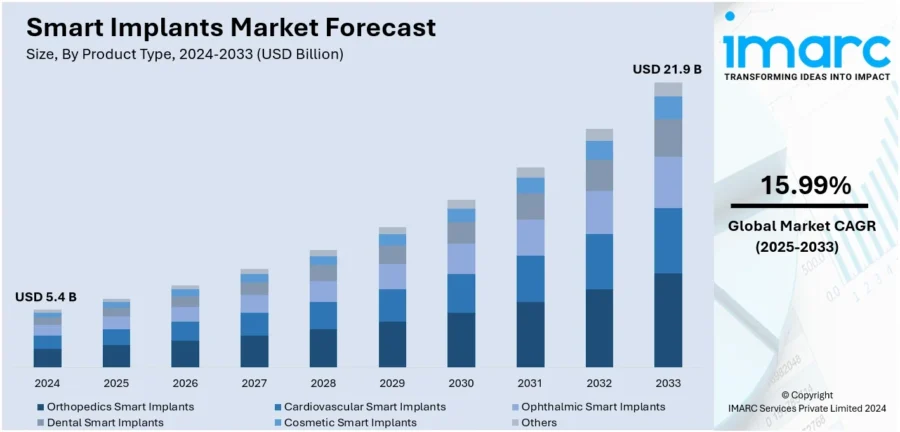
Source: IMARC Group
One notable use case smart pacemakers that track heart rhythms and send real-time data to healthcare providers. It allows early detection of abnormal heart activity and immediate adjustments to treatments.
Another innovative application is implantable drug delivery systems that deliver drugs like pain relief medication or chemotherapy at adjustable rates.
This technology enables precise dosing based on real-time feedback from the patient’s body. Lastly, smart prosthetics are making significant strides by automatically adjusting their movements based on user behavior, enhancing comfort and functionality.
These IoT smart implants ensure constant monitoring and personalized care offering prosthetics that continuously learn and adapt to the user’s needs.
Startup to Watch: VesselSens
German startup VesselSens develops an implantable sensor system for wireless restenosis detection, designed to be implanted in coronary or peripheral arteries during stent implantation or balloon angioplasty.
The sensor communicates with an external readout device placed on the patient’s body, transmitting data to the cloud for analysis. The system provides real-time restenosis assessments, enabling physicians to detect trends and make early diagnoses.
Its key features include continuous monitoring, fast data transmission, and web-based accessibility for clinicians and patients. VesselSens enhances diagnostic accuracy and improves patient outcomes through timely interventions.
Leverage the Latest IoT Innovations in Healthcare
Key investors, including MassChallenge, Techstars, Google for Startups, Medtech Innovator, and SOSV, lead funding in healthcare. The top funding types- Seed, Early-stage VC, Accelerator, Pre-Seed, and Angel — average $9.3 million per round, fostering early innovation and growth in emerging healthcare technologies.
With StartUs Insights, you swiftly discover hidden gems among over 4.7 million startups, scaleups, and tech companies, supported by 20,000 trends and technologies. Our AI-powered search and real-time database ensure exclusive access to innovative solutions, making the global innovation landscape easy to navigate.
Trusted by industry leaders like Samsung, Nestlé, and Magna, we provide unmatched data, a 360-degree industry view, and data-driven intelligence for confident strategic decisions.
Leverage our innovation services to optimize costs, streamline operations, and stay ahead of the curve. Get in touch today to explore how our comprehensive innovation intelligence can drive your success.



